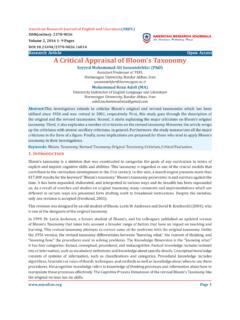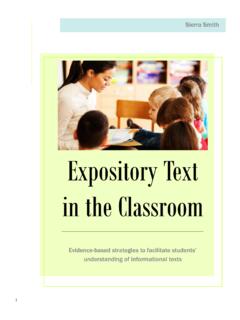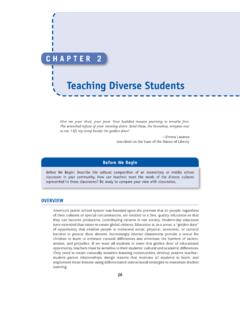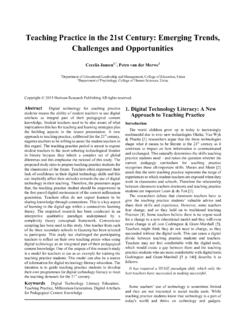Transcription of A Critical Review of Constructivist Theory and the ...
1 Page 1A Critical Review of Constructivist Theory and the Emergence of ConstructionismAhmed AlanaziUniversity of Kansas, School of IntroductionEducational theorists have long tried to understand how information is accumulated, transferred, and understood from one individual to the next. If educators could only understand this process fully, we could harness the power of knowledge transfer to enhance the learning outcomes of our students. One of the pioneers of education Theory , John Dewey, asserted that knowledge was transmitted from one generation to the next by presentation of information by the learned and re-construction of this information by the learner, solidifying that person s understanding of this new information (1916).
2 In other words, it is constructed by learners (Hmelo-Silver, Duncan, & Chinn, 2007) and built on prior experiences. Constructivism posits that learners must consciously think about deriving meaning when listening or watching the instructor who is facilitating their learning environments, and with this observation, learners construct their own knowledge. Divergent though their respective theories might be, Piaget, Brown, and Thomas all emphasize the principle idea that learning occurs through social interaction (Piaget & Inhelder, 2008; Thomas & Brown, 2011). This Review of constructivism aims to highlight the social drivers behind the formation of knowledge structures in the minds of learn and develop knowledge individually in social learning environments by constructing their own schema based on the information presented to them.
3 For example, when students arrive on the first day of classes and they observe how the instructor is turning on the computer, the projector, and then pulling the screen all the way down to cover the blackboard, they learn what steps it takes for the instructor to prepare Research Article Open AccessAbstract: Perhaps one of the most powerful influences on students success in the classroom is the teaching method implemented by the instructor.
4 This paper discusses the Constructivist approach, how it has been criticized, and the subsequent evolution of the constructionist approach. Constructivism is most closely associated with the Swiss psychologist Jean Piaget (1896-1980) whose epistemological Theory is considered one of the most influential Constructivist theories in education. In the wake of Piaget, his student Seymour Papert put forth the more developed concept of constructionism. This paper discusses how learners construct knowledge on schemas of prior knowledge through the lenses of both constructivism and constructionism, posits critiques that assess the Constructivist approach, summarizes how proponents of constructivism respond to those critiques, and outlines key components of constructivism.
5 Although both constructivism and constructionism have supporters and opponents, further research is needed on the effectiveness of Constructivist and constructionist teaching methodologies to ensure which approach is most effective for educational learning : constructivism, constructionism, learning approaches, learning Research Journal of Humanities and social sciences (ARJHSS) ISSN (Online) : 2378-7031 Volume 2, 2016, 1-8 pagesDOI: 2the classroom. Constructivists assert that learners construct knowledge rather than acquire new knowledge; therefore, learning is an active process throughout the learners experiences and the environment in which they are learning.
6 Accepting Constructivist learning theories means following the path of social learning pioneers such as Vygotsky and Leontiev as well as Brown, Collin, and Duguid. All of the aforementioned proponents of social learning argue that learning is an interactive, social process. Accepting constructivism also means that we must focus the majority of our attention on learners and on creating collaborative, interactive environments. Just prior to the advent of constructivism as it is known today, Vygotsky defined the Zone of Proximate Development (ZPD) which denotes the distance between what learners can achieve by themselves, their actual development, and what they can achieve with the help with others.
7 This concept not only brought to light the social nature of learning, but to this day remains one of the most prevailing Constructivist concepts within education (Vygotsky, 1978). Swiss psychologist Jean Piaget s epistemological Theory is considered one of the most influential Constructivist theories (Jonassen, 1991). According to Piaget, the knowledge people interact with is added to schemas of prior knowledge wherein learners construct knowledge. This knowledge is formed by learners own experiences, and hence this construction varies among learners(Hmelo-Silver et al., 2007; Jonassen, 1991; Mayer, 2004). In other words, learners conceptualize and perceive concepts differently based on their prior experiences (Jonassen, 1991).
8 Constructivism indicates that knowledge is constructed based on the already existing knowledge in learners minds (Hmelo-Silver et al., 2007). Criticism of ConstructivismThough many educators have embraced constructivism, it is not without its critics. Several arguments have been developed to criticize Constructivist approaches. Some of the researchers opposing constructivism, for example, the very vocalKirschner, Sweller, and Clark (2006), have posited the belief that constructivism promotes a teaching style with unguided or minimally guided instructions for students. Researchers such as Brown and Campione, 1994; Hardiman, Pollatsek, and Weil, 1986; Moreno, 2004; and Tuovinen and Sweller, 1999 indicate that when students learn with minimal instructions, they become lost and frustrated (Kirschner, Sweller,& Clark, 2006, ).
9 The practice of designing minimally-guided instruction ignores the importance and structure of working memory during learning. Researchers such as Kirschner et al.(2006) indicate that minimally-guided approaches as practiced through Constructivist approaches ignore empirical studies that have shown that unguided instructions are not effective in learning concern held by critics of constructivism is that learners need to connect their knowledge to tangible objects in order to ensure that they have acquired the knowledge, and Constructivist approaches do not support this learning-related need. According to these critics, cognitive learning is not enough for individuals; one must demonstrate knowledge by making artifacts (Papert & Harel, 1991).
10 For example, a web design teacher may design a lesson plan with the objective that every student should be able to design a web page using Hypertext Markup Language (HTML) by the end of the semester. If the teacher were to embrace a Constructivist approach, he or she might have the students discuss designing a web page in a group or complete problem-solving exercises without a large amount of teacher-provided instruction. According to the Constructivist point of view, students will acquire knowledge through interacting with their peers. Conversely, a teacher who embraces a more structured approach might expect students to acquire knowledge through a lecture and to then demonstrate this newly acquired knowledge through the passage of a written Constructivist approaches, students have learned that they can negotiate designing a web page using HTML in a meaningful way through conversation or by a problem-based learning approach, not necessarily through the creation of the webpage itself.














